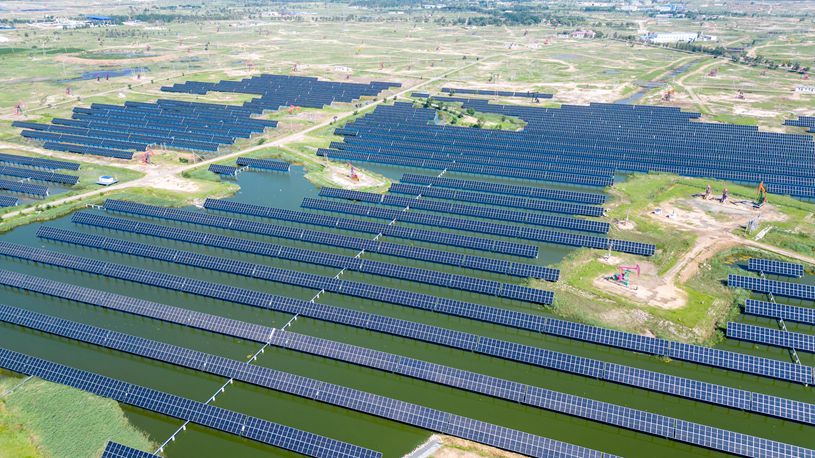Xinhua Headlines: Climate alarms raised as extreme heat waves sweep globe
Source: Xinhua
Editor: huaxia
2024-08-14 16:52:34
* Prolonged and severe heatwaves have hit every continent, with at least 10 countries experiencing daily temperatures exceeding 50 degrees Celsius in multiple areas over the past year, according to the WMO.
* Extreme heat damages infrastructure and strains essential services, including water, electricity, health and food supplies.
* A key solution is the rapid reduction of greenhouse gas emissions. Investment in clean energy technologies, such as wind, solar and hydroelectric power, is crucial to achieving this goal.
by Xinhua writer Zeng Yan
GENEVA, Aug. 14 (Xinhua) -- A major wildfire had been contained in the suburbs of Athens since Sunday, leaving one person dead, thousands evacuated and significant damage by Tuesday morning.
Greek firefighters have been battling wildfires across the country every day since May. The spate of fires comes after a report released by the UN World Meteorological Organization (WMO) and the European Union's climate agency Copernicus that Europe has become the fastest-warming continent in the world, with temperatures rising at roughly twice the global average.
In July, a streak of 13 consecutive months of record-breaking temperatures finally ended, Copernicus said last week. However, experts warned of the persistent threat posed by climate change.
"The overall context hasn't changed. Our climate continues to warm," said Copernicus Deputy Director Samantha Burgess. "The devastating effects of climate change started well before 2023 and will continue until global greenhouse gas emissions reach net zero."
RED ALERT
Prolonged and severe heatwaves have hit every continent, with at least 10 countries experiencing daily temperatures exceeding 50 degrees Celsius in multiple areas over the past year, according to the WMO.
Japan's average temperature for July reached its highest level since records began in 1898. Japanese authorities said more than 120 people had died of heatstroke in Tokyo.
Spain recorded 608 deaths attributable to high temperatures in the first week starting August, almost double the previous week's total of 335, according to the Carlos III Health Institute.
Death Valley in California, the United States, recorded its hottest month in July, with an average 24-hour temperature of 42.5 degrees Celsius.
Even remote Antarctica was not spared. In July, ground temperatures soared by an average of 10 degrees Celsius above usual levels across large swathes of Antarctica's ice sheets. Antarctic sea ice extent was 11 percent below average, the second-lowest level for July in the satellite data records, behind only the lowest July value observed in 2023.
Wildfires are no surprise against such a backdrop. Thousands of residents have fled their homes recently due to extensive wildfires spreading towards Athens, fueled by scorching and windy weather. The EU's Civil Protection Mechanism has been activated multiple times this summer to help European countries, including Portugal, Greece and Albania, tackle severe wildfires.
Extreme heat damages infrastructure and strains essential services, including water, electricity, health and food supplies. According to a study published in 2021 by the Journal of Environmental Economics and Management, climate change could reduce global crop yields by 3-12 percent by mid-century and 11-25 percent by the century's end.
DECODING HEAT
WMO climate expert Alvaro Silva told Xinhua in an interview that several climate factors may play a role in driving such extreme weather events, such as El Nino and La Nina. "Human-induced climate change is the most important one and spans across all these scales," Silva added.
The main culprit is the excessive accumulation of greenhouse gases in the atmosphere, primarily from human activities such as burning fossil fuels and deforestation. Humanity is, therefore, facing a rapidly warming planet. July saw temperatures 1.48 degrees Celsius above pre-industrial levels.
Besides global warming, the most significant factor influencing Earth's temperature is the El Nino-Southern Oscillation (ENSO), a natural climate pattern that impacts global weather. El Nino, the warming phase of ENSO that fueled record temperatures and extreme events, has recently ended.
Nevertheless, Silva warned that La Nina, the cooling phase of ENSO, is predicted to develop later this year. This may cause or exacerbate some extreme weather events.
Additionally, specific regional anomalies have also exacerbated the situation. Copernicus' analysis suggested that Antarctica's heatwave had driven the global temperature spike in recent weeks.
WARMER 2024?
Extreme events such as heat waves, flooding, drought and raging wildfires are increasingly the norm. The WMO has predicted an 80 percent chance that the global average temperature will temporarily exceed 1.5 degrees Celsius above pre-industrial levels for at least one of the next five years, inching closer to the warming threshold set by the Paris Agreement.
Whether or not 2024 will be hotter than the record-breaking 2023 will largely depend on the development and intensity of La Nina later this year, Copernicus said. The EU climate agency added that the exceptional warmth of the last four months of 2023 makes it too early to predict with confidence which year will be warmer.
Gregor Vertacnik, a climatologist at Slovenia's State Agency for the Environment, told Xinhua that further temperature increases, frequent and intense summer heatwaves, and severe droughts are expected.
Regional and cross-border response measures are essential in the face of severe climate challenges. This year's heatwaves are a stark reminder of the need for urgent climate action.
A key solution is the rapid reduction of greenhouse gas emissions. This includes phasing out fossil fuels, the primary drivers of climate change, and accelerating the transition to renewable energy sources. Investment in clean energy technologies, such as wind, solar and hydroelectric power, is crucial to achieving this goal.
Better early warning systems and heat-health action plans can also help. The WMO and the World Health Organization estimate that scaling up heat health-warning systems for 57 countries could save nearly 100,000 lives annually. "Heat illness and deaths are preventable, and many impacts can be minimized with targeted economic and social policies and concrete actions," the UN's climate and weather agency said.
Adaptation measures are also essential to cope with the immediate effects of extreme heat. These include designing heat-resistant infrastructure, improving urban planning to reduce heat islands, and developing strategies to protect crops and food supplies from heat stress.
(Kang Yi, Zhang Zhaoqing, Pan Geping in Brussels, Zhao Xiaona, Zhang Boning in London, Luo Yu in Paris, Ren Yaoting in Rome, Chu Yi, Du Zheyu in Berlin, Shan Weiyi in Frankfurt, Wen Xinnian in Lisbon, Zhang Yuliang in Oslo, Wang Xiangjiang in The Hague, Cui Li in Warsaw, Deng Yaomin in Prague, Li Xuejun in Zagreb, Zhang Gaiping in Bucharest, Chong Dahai in Tirana, Xue Dongmei in Vilnius, Yin Xiaosheng in Sarajevo also contributed to the story.)(Video reporters: Zeng Yan, Zhang Xin, Chen Gang, Zhou Yue, He Canling, Zhao Xiaona, Yang Zhixiang, Tu Yifan, Peng Zhuo, and Ren Yaoting; Video editors: Zhu Cong, Zak Zuzanna, Li Qin, and Lin Lin)■












Comments